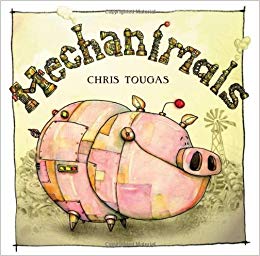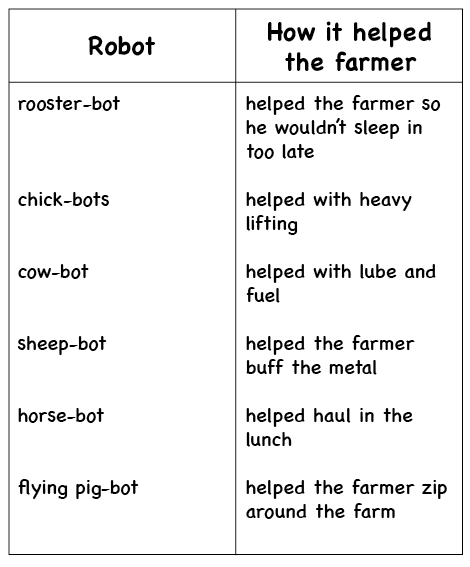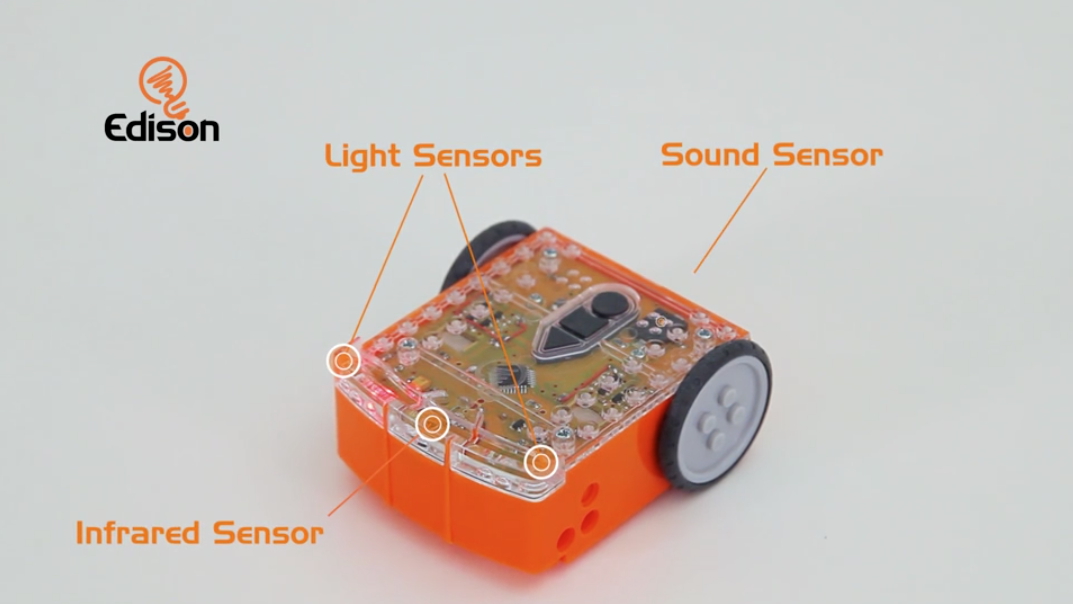Agricultural Literacy Curriculum Matrix
Lesson Plan
Robots in High-Tech Farming (Grades 3-5)
Grade Level
Purpose
Students discover the four main components of robots, explore how robots are used in agriculture, and program and operate a robot to address a farming challenge. Grades 3-5
Estimated Time
Materials Needed
Engage:
- Mechanimals by Chris Tougas or Mechanimals video
Activity 1: What is a Robot?
- What is a Robot? activity sheet
- Robot (We tested the Edison robot STEM starter pack. If using a different robot, feel free to adapt the instructions to meet your robot's specifications.)
Activity 2: Robots in Agriculture
- Laptop or tablet
- How Robots Will Shape Agriculture's Future—Yield of Dreams video
- ecoRobotix Smart Weeding Robot video
- Octopus Poultry Safe and Scarifier in ACTION video
- Hands Free Hectare - harvest of winter wheat video
- Robots speed up lettuce harvest process video
Activity 3: Farm Robotics Challenge
- EdCreate Teaching Guide
- Farm Robotics Challenge Preparation Instructions
- Robot (We tested the Edison robot STEM starter pack. If using a different robot, feel free to adapt the instructions to meet your robot's specifications.)
- Getting Started with Edison Guide
- Computer, 1 per group
- EdScratch App
- EdScratch Information and Tutorial Videos
- Farm Robotics Challenge Cards, 1 card per group
- EdDigger Instructions
Vocabulary
computer: an electronic device for storing and processing data according to instructions given to it in a variable program
computer program: a collection of instructions that tell a computer to perform a specific task
input: a device through which information enters a system
labor: the services performed by workers for wages
output: a place where power or information leaves a system
power source: a source of electrical energy, such as a battery
precision agriculture: an information technology-based, site-specific farm management system that collects and responds to data ensuring that crops receive exactly what they need for optimum health and productivity
robot: a mechanical device that is capable of performing a variety of tasks on command or according to instructions programmed in advance
sensor: a device that detects or measures a physical property and records, indicates, or otherwise responds to it
Did You Know?
- Harper Adams University's Hands Free Hectare project has successfully grown and harvested a hectare (2.471 acres) of cereal crops without humans entering the field by using autonomous machinery and remote agronomy.3
- The word "robot" comes from the Czech word robota, meaning drudgery, servitude, or forced labor.4
- The National Robotics Initiative (NRI-2.0) program is a partnership between the United States Department of Agriculture's (USDA) National Institute of Food and Agriculture (NIFA), the National Science Foundation, the Department of Defense, and the Department of Energy and supports foundational research in robotic science and technology.5
Background Agricultural Connections
A robot is a mechanical device that is capable of performing a variety of tasks on command or according to instructions programmed in advance. Robots can do jobs that are repetitive, boring, messy, difficult, or hazardous for humans. Robots have several advantages over human workers. Unlike humans, robots can work virtually nonstop without becoming strained or injured by repeated movements. They can be built to be much stronger than people, and they deliver consistent results. Robots can perform tasks faster, longer, more accurately, and more efficiently than humans. All robots are machines, but not all machines are robots. Robots take input from the environment and use that input to make decisions. Robots are reprogrammable and multipurpose. One robot has the potential to perform a variety of different tasks.
A robot is made up of four main components—a computer, inputs, outputs, and a power source. The computer is the brain of the robot. A robot follows specific instructions in the form of a computer program. Sensors are inputs that provide information to the computer and determine what a robot will do according to how it has been programmed. An output is a command sent by the robot's computer to another part of the robot. For example, the computer can send a command to the robot's motor to make it move. Robots are typically powered by batteries which provide energy for the robot to function.
Agricultural robots perform farming tasks. Robots are used on crop farms for harvesting, weed control, mowing, pruning, seeding, monitoring, spraying, sorting, and packing. On livestock farms, robots can perform the tasks of feeding, milking, monitoring, cleaning, and herding. Robot applications in precision agriculture can save time, money, and resources and be more profitable, efficient, environmentally friendly, and safe.
Robots can be seen as one solution to food production labor shortages. With an aging agricultural workforce and changes to immigration laws, labor scarcity is a big issue facing the agriculture industry. There are jobs on the farm that do not create value at or above minimum wage. By automating sub-minimum wage jobs, more food can be produced at a lower cost.1
Robot technologies enable more reliable monitoring and management of natural resources, such as air, soil, and water quality. They also give producers greater control over plant and animal production, processing, distribution, and storage resulting in greater efficiencies and lower prices, safer growing conditions and food, and reduced environmental and ecological impacts.2
Engage
- Read the book Mechanimals by Chris Tougas aloud
 to the class or show the Mechanimals video.
to the class or show the Mechanimals video. - As a class, discuss the differences between fiction and non-fiction books. Ask the students, "What type of book is Mechanimals?" (fiction)
- Make a two-column chart on the board. Title the first column "Robot" and the second column "How it helped the farmer." Ask the class to list the robots from the book in the first column of the chart, and describe how the robot helped the farmer in the second column.

- Discuss the idea that, even though the book is fictional, robots are used on farms to perform tasks more efficiently.
Explore and Explain
Activity 1: What is a Robot?
- Hand out the What is a Robot? activity sheet to each student.
- Ask the students to write a description of a robot on their activity sheet and explain how a robot is different from a machine.
- Have the students draw a picture of a robot and then list the tasks the robot can perform.
- Allow time for the students to share their descriptions, pictures, and lists with a partner.
- Introduce the definition of a robot, "A mechanical device that is capable of performing a variety of tasks on command or according to instructions programmed in advance." Discuss how the students' descriptions, pictures, and lists fit with this definition.
- Show the students the Edison robot. Explain that a robot has four main components—a computer, inputs, outputs, and a power source. Point to the microchip located just above the play button. Explain that the robot has a computer chip inside that is the brain of the robot. The robot will follow specific instructions that are programmed to the computer chip.
- Point out the infrared, light, and sound sensors. Explain that sensors are inputs that provide information to the computer and determine what the robot will do according to how it has been programmed.

- Explain that an output is a command sent by the robot's computer to another part of the robot. Demonstrate how the robot moves when the robot's computer sends a command to its motor.
- Show the students where the robot's batteries are located. Explain that a robot requires a power source which provides energy for the robot to function.
- Ask the students, "Why do engineers design robots?" Lead a discussion about this question. Integrate the following points into the discussion:
- Robots can do jobs that are repetitive, boring, messy, difficult, or hazardous for humans.
- Unlike humans, robots can work virtually nonstop without becoming strained or injured by repeated movements.
- Robots can be built to be much stronger than people.
- Robots deliver consistent results.
- Robots can perform tasks faster, longer, more accurately, and more efficiently than humans.
Activity 2: Robots in Agriculture
- Pose the following question to the class for a Think, Pair, Share activity. "How do you think robots can be helpful on a farm?"
- Have the students think about the question individually, pair with a partner to discuss their ideas, and share their ideas with the class. Make a list of the ideas on the board.
- Organize the class into five groups. Provide each group with a tablet or laptop. Assign each group one of the following videos to watch on their tablet or laptop.
- Robotic Milker: How Robots Will Shape Agriculture's Future—Yield of Dreams
- Automated Robot Weeder: ecoRobotix Smart Weeding Robot
- Poultry Robot: Octopus Safe and Scarifier in ACTION
- Autonomous Combine Harvester: Hands Free Hectare - harvest of winter wheat
- Robotic Lettuce Harvester: Robots speed up lettuce harvest process
- Robotic Milker: How Robots Will Shape Agriculture's Future—Yield of Dreams
- After viewing the videos, have the students work together in their groups to create a commercial to persuade farmers to buy the robot from the video their group viewed. Groups can either act out their commercial live or film and edit their commercial using a movie-making platform such as iMovie or WeVideo. The commercials should include the following:
- Name of the robot
- Tasks the robot can perform
- Ways the robot can be useful on a farm
- Ways the robot can help a farmer save time, money, and/or resources
- Allow time for the groups to share their commercials with the class.
- Refer back to the question, "How do you think robots can be helpful on a farm?" Ask the students if they have any other ideas to add to the list after viewing their classmates' commercials. Add new ideas to the list until it includes at least the following uses for robots on farms:
- Harvesting
- Weed control
- Mowing
- Pruning
- Seeding
- Monitoring
- Spraying
- Sorting
- Packing
- Feeding
- Milking
- Cleaning
- Herding
Activity 3: Farm Robotics Challenge
- Prior to this activity, familiarize yourself with the Edison robot and its functions and the EdScratch programming language. The EdCreate Teaching Guide provides helpful tips to complement the EdBuild instructions. Prepare the Farm Robotics Challenge Courses according to the Farm Robotics Challenge Preparation Instructions for each challenge your students will be participating in.
- Organize the class into small groups. Provide each group with a Farm Robotics Challenge Card and access to a computer. You may choose to have all groups work on the same challenge or have different groups work on different challenges.
- Each card contains a QR code that will take students to a video showing one way the farming task can be performed without a robot. If your class does not have the ability to scan QR codes, use the following links to view the videos:
- Self-guided Tractor: Classic Fertilizer Spreading
- Moving Hay Bales: Bobcat S175 Moving/Loading Hay Bales
- After the groups watch the video from their card, have them discuss how robots can help make the task easier and more efficient.
- If the students are doing the "Moving Hay Bales" challenge, provide them with the link for the EdDigger instructions. Have the groups work together to build their robot using parts from the EdCreate Kit and lego pieces to meet the challenge from their card.
- Robots can be programmed using an Edison programming language. EdScratch is the recommended programming language for students ages 10+. Provide instruction on programming with EdScratch, and access to the EdScratch app.
- After students have had an opportunity to program commands for the robot to perform based on the challenge from their Farm Robotics Challenge Card, have them test their robot's ability to complete the challenge. During testing, groups should check the boxes on their card for each requirement that was successfully met during the test. Adjustments should be made and tested until each box can be checked off.
Evaluate
After conducting these activities, review and summarize the following key concepts:
- A robot is a mechanical device that is capable of performing a variety of tasks on command or according to instructions programmed in advance.
- A robot is made up of four main components—a computer, inputs, outputs, and a power source.
- Robots are used on crop farms for harvesting, weed control, mowing, pruning, seeding, monitoring, spraying, sorting, and packing. On livestock farms, robots can perform the tasks of feeding, milking, monitoring, cleaning, and herding.
- Agricultural robots can save time, money, and resources and increase profitability, efficiency, environmental protections, and safety.
Sources
- https://www.theautomationengineer.com/markets-sectors/automated-agriculture-robots-future-farming/
- https://nifa.usda.gov/topic/agriculture-technology
- http://www.handsfreehectare.com/
- https://www.sciencefriday.com/segments/the-origin-of-the-word-robot/
- https://nifa.usda.gov/announcement/usdas-national-institute-food-and-agriculture-announces-support-collaborative-robotics
Recommended Companion Resources
- Agricultural Drones
- Agricultural Engineering Video
- Agricultural Inventions: At the Top of the Field
- Agriculture Technology Advancements Video Playlist
- Field Robots of the Future
- Fighting Weeds: Can we reduce, or even eliminate herbicides by utilizing robotics and AI?
- Precision Agriculture Technologies and Factors Affecting Their Adoption
- Robotic Farming of the Future
- The Farming Robots of Tomorrow are Here Today
- The Future of Farming & Agriculture Video
- The Magic School Bus Rides Again: Robot Farm
- What Happens When Farming Goes High-Tech?
Author
Organization
| We welcome your feedback! If you have a question about this lesson or would like to report a broken link, please send us an email at [email protected]. If you have used this lesson and are willing to share your experience, we will provide you with a coupon code for 10% off your next purchase at AgClassroomStore. |
